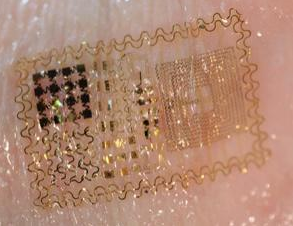There's not much sexy--let alone unobtrusive--about many of today's medical monitoring devices, given the many wires and electrodes that are often needed to collect data from a patient. But that may be about to change. John A. Rogers, a professor of materials science at the University of Illinois at Urbana-Champaign, has created an "electronic tattoo" that could be worn by a patient to monitor various body functions, according to reports in New Scientist and Technology Review about recent research published in the journal Science. The new technology is pliable and can twist and move with the skin. Technology Review describes the concepts behind Rogers's work:
To achieve flexible, stretchable electronics, Rogers employed a principle he had already used to achieve flexibility in substrates. He made the components--all composed of traditional, high-performance materials like silicon--not only incredibly thin, but also "structured into a serpentine shape" that allows them to deform without breaking. The result, says Rogers, is that "the whole system takes on this kind of spiderweb layout."

A prototype of the tattoo was fitted with electrodes to measure electric signals produced by muscle and brain activity. This kind of monitoring capability could be used for various purposes, such as sleep apnea or monitoring of premature babies' heart activity. Roger also speculates that the tattoos could potentially also be used to stimulate muscles for patients undergoing physical rehabilitation. To see a prototype for yourself, check out this short video:


